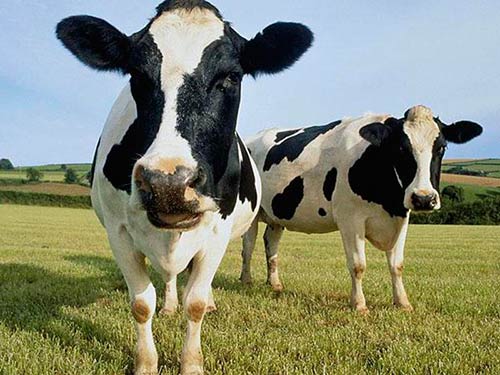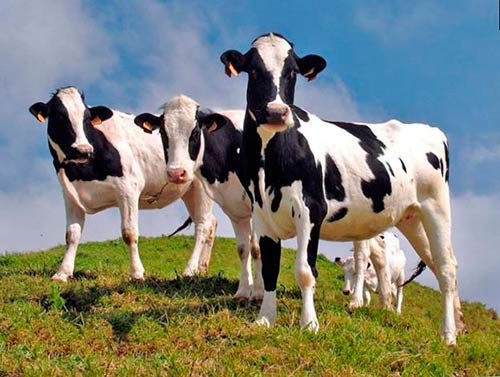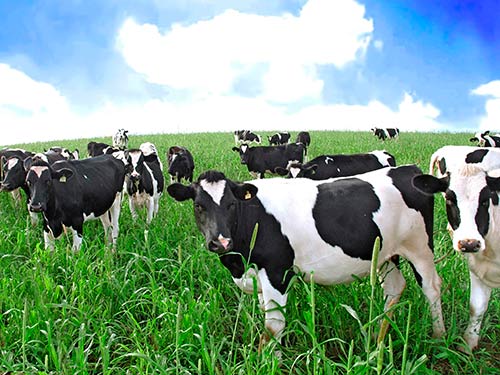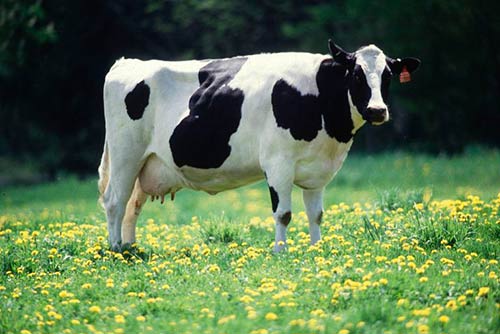See also
- Artificial insemination
- Breed of bees
- Breed's of cows
- Breeds of pigs
- Calving cows. How to prepare for calving. Receiving calf
- Dairy breeds of cows and bulls. The productivity of dairy cattle
- Duroc
- Estimation of bulls on quality of posterity
- Hereford cattle
- Holstein breed
- Landrace - bacon pigs
- Limousin cattle breed
- Marble beef
- Mastitis in cows
- Meat breed of sheep, their characteristics and photo
- Meat breeds of cows and bulls. The productivity of beef cattle
- Simmental breed of cattle
- The Aberdeen-Angus cows. Description and characteristics of the breed
- The farrowing of pigs: preparing for farrowing, farrowing, care of a pig and piglets after farrowing
- The Yorkshire breed of pigs
- Vietnamese pigs. Description of the breed, breeding, maintenance and care
- What is the difference netel from heifers or cows?
- What is the meat yield in pigs — a mechanism to define and calculate deadweight
- Zootechnical rules
It's interesting
Holstein breed
Among cows of the dairy direction of particular popularity in many countries find Holstein cows, bred in the 19th century in the United States. They are not only impressive milk yields, but also significant weight, which is more typical for cows of the meat direction. Bulls of the Holstein breed that with proper feeding, can reach more than one ton of live weight, are the producers of valuable seed and a great option for farms and individuals, specializing in the production of beef.

The Holstein breed is a great choice farmer
Origin
Although the Holstein cattle breed was developed in North America, but her ancestors were representatives of the black and white cattle, which were bred on the territory of some countries of Western Europe - Holland, Germany, Belgium. First black-and-white cows were imported into the United States in the mid-19th century. Winthrop Chenery, who bought the first herd those cows, I noticed their high milk production and decided to improve it's quality. Thanks to the fruitful work, created in 1871, the society of breeders breeding Holstein-Friesian cattle and the establishment of herd books, cattle of this breed in the next year began to breed in 12 States of the country. In 1983 in Canada and the U.S. the name was changed and there was only the first part of Holstein. Although there is still some sources mention the old name.

High milk yield
Description
Holstein-Friesian breed of cows different from other not only lots of milk, but purely external signs. As a rule, its members have black-and-white suit – the ratio of white and black color on the skin of each animal individually. Sometimes can be born completely black calves with small white spots on legs and tail. In the process of selective sampling is also possible offspring with red-and-white suit. This is due to the action of a recessive gene. Previously, these calves of Holstein-Friesian breed were discarded and, accordingly, did not allow for further playback. Since 1971, the instances selected for the formation of a separate breed.
Despite the dairy Holstein-Friesian cattle of holstine achieve significant weight: adults Chicks weigh around 600-700 kg, the average weight of bulls of Holstein-Friesian breed is 900 kg With strengthened and balanced diet to achieve greater weight cows up to 800-900 kg and bulls up to 1200 kg.

the Holstein breed has a great weight gain
the height at the withers is 145-150 cm, bulls, the figure is naturally higher – about 160 cm, Weight of newborn calves varies from 38 to 42 kg, bulls-holstine have an average weight of 45 kg. the breed is characterized by a deep chest – 83-86 cm, chest width averages 64 cm, width of the pelvis – about 62 cm
Cows have the exterior of the corresponding milk type:
- and deep wedge-shaped body;
- long, wide shoulders;
- rather broad rump;
- the udder is big but toned, with distinct veins.
Feature productivity
Cows Holstein-Friesian breed are characterized by the highest milk yield among other dairy breeds. Specific indicators of milk yield and milk fat depend on the climate of a particular locality and prey. So, for example, Israel has managed to achieve such a balance of all the necessary conditions, what you get from them every year about 10 thousand kg of milk. The fat content of this product usually does not exceed 3-3,1%, and the amount of protein at the level of 3%. In North America the Holstein dairy breed cows has a little less milk – about 8-9 thousand kg of milk annually, but the percentage of fat and protein in it more and 3.6 and 3.2, respectively. Holstein cows with red-and-white colouring give more milk fat, often reaching a level of 3.95%, but the amount of milk is considerably lagging behind the black-and-white suit – within 4 thousand pounds.
Holstein Cows can be described also as the Champions of the milk yield. In 1983 from one of the cows managed to get just over 25 thousand kg of milk per 305 days of lactation. Naturally, with this amount of milk fat it was slightly lower than usual – about 2.8%.

Breed a n d Holstein cows are very resistant to diseases
Despite such high levels of milk production should not delude – to achieve good results, it is necessary to provide not only a sufficient amount of feed, and their balance. In winter forage consisting of corn grain and hay of legumes, high-fat meal. Summer diet should consist of large number of succulent green fodder.
Summing up, we can distinguish several main advantages:
- High rate of milk production;
- High adaptation to various climatic conditions;
- Resistance to diseases (with appropriate care);
- Cleanliness.
Reviews of farmers on the Holstein breed of cows, as a rule, very good. With the abundance of forage resources and availability of land for summer grazing of animals you can get a great yield. And the fact that in the United States, Canada, Germany, Israel and many other countries, mainly engaged in breeding of this breed, is additional advertising and encouragement to buy them. Furthermore, Holstein breed is often used to increase the efficiency of any black-and-white cattle, this means that the demand for the Holstein breed of cattle will always be high.

